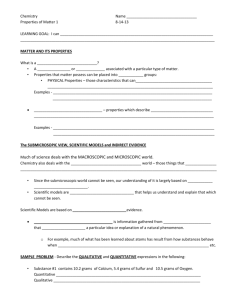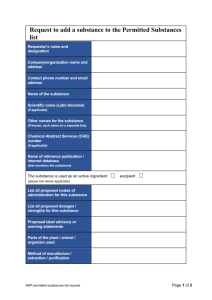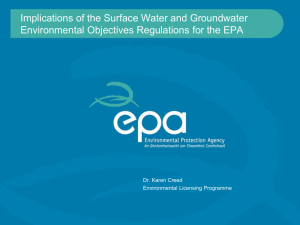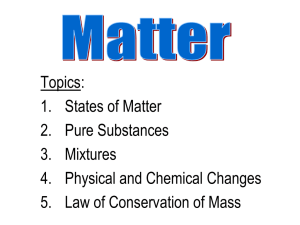Prioritisation of Contaminants of Emerging Concern in Groundwater
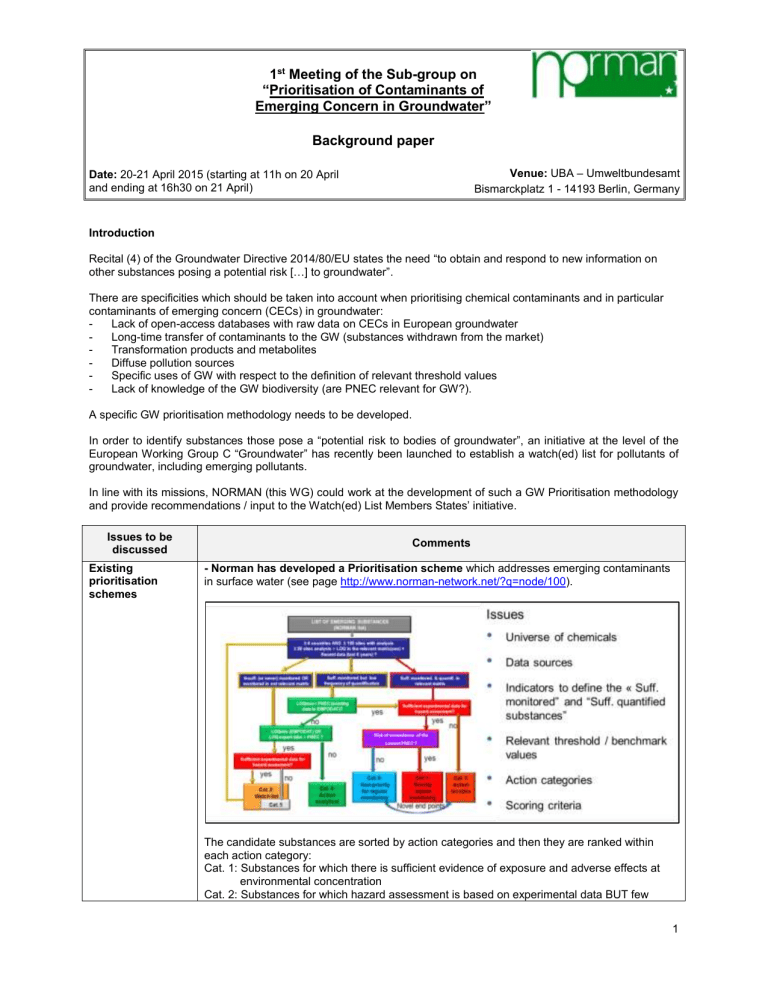
1
st
Meeting of the Sub-group on
“Prioritisation of Contaminants of
Emerging Concern in Groundwater ”
Background paper
Date: 20-21 April 2015 (starting at 11h on 20 April and ending at 16h30 on 21 April)
Venue: UBA – Umweltbundesamt
Bismarckplatz 1 - 14193 Berlin, Germany
Introduction
Recital (4) of the Groundwater Directive 2014/80/EU states the need
“to obtain and respond to new information on other substances posing a potential risk […] to groundwater”.
There are specificities which should be taken into account when prioritising chemical contaminants and in particular contaminants of emerging concern (CECs) in groundwater:
- Lack of open-access databases with raw data on CECs in European groundwater
- Long-time transfer of contaminants to the GW (substances withdrawn from the market)
- Transformation products and metabolites
- Diffuse pollution sources
- Specific uses of GW with respect to the definition of relevant threshold values
- Lack of knowledge of the GW biodiversity (are PNEC relevant for GW?).
A specific GW prioritisation methodology needs to be developed.
In order t o identify substances those pose a “potential risk to bodies of groundwater”, an initiative at the level of the
European Working Group C “Groundwater” has recently been launched to establish a watch(ed) list for pollutants of groundwater, including emerging pollutants.
In line with its missions, NORMAN (this WG) could work at the development of such a GW Prioritisation methodology and provide recommendations / input to the Watch(ed) List
Members States’ initiative.
Issues to be discussed
Existing prioritisation schemes
Comments
- Norman has developed a Prioritisation scheme in surface water (see page which addresses emerging contaminants http://www.norman-network.net/?q=node/100 ).
The candidate substances are sorted by action categories and then they are ranked within each action category:
Cat. 1: Substances for which there is sufficient evidence of exposure and adverse effects at environmental concentration
Cat. 2: Substances for which hazard assessment is based on experimental data BUT few
1
Data sources
Critical issues for substances categorisation monitoring data are available
Cat. 3: Substances for which there is evidence of exposure BUT hazard assessment is based on predicted toxicity (P-PNEC)
Cat 4: Substances for which hazard assessment is based on experimental data BUT analytical capabilities are not yet satisfactory
Cat. 5: Substances for which no or few monitoring data are available AND hazard assessment is based on predicted toxicity (P-PNEC)
Cat. 6: Substances for which toxicity data are sufficient for the derivation of an EQS and there is evidence that the exposure does not pose a hazard to ecosystems.
Do we agree that a similar approach (prioritisation by action category) could be applied for prioritisation of emerging contaminants in groundwater? Or should we develop a completely different approach?
If we agree on this approach, what are the relevant action categories for CECs on GW?
Data needed:
1) General information on substances and their uses (point sources or diffuse contamination?)
2) Fate in soil and in GW (adsorption constants, DT50, solubility, metabolites etc…)
3) Toxicity and ecotoxicity of substances
4) Current and past regulatory status, period of use, use restrictions, date of withdrawn from the market
5) Raw data on occurrence of CECs in GW
The NORMAN EMPODAT database is a geo-referenced monitoring / occurrence database on emerging substances. EMPODAT contains already datasets on GW but for a limited number of countries.
EMPODAT can be used as a repository tool for datasets of CECs in GW. A reporting data template already exists for GW but it can be reviewed / improved, where needed by the GW
Sub-group.
Are there other open access databases available in Europe?
1.1. Does the group agree to share datasets (published data) on CECs in GW to
NORMAN EMPODAT?
1.2. Who is willing and can provide datasets on CECs in GW?
Assuming that the concept of the existing NORMAN categorisation and prioritisation scheme is adopted, adaptation of this scheme to GW poses several questions:
What is the universe of chemicals?
As time transfer towards GW may be long (decades and more), particular attention should be paid to withdrawn substances.
During their transfer, substances could be degraded in transformation products that can be more toxic/ecotoxic than their parents. As a result, metabolites play an important role in GW quality assessment.
What are the relevant indicators that define the “sufficiently monitored and sufficiently quantified substances
” in GW?
Level of investigation =
N° of countries? Number/Density of sites? Representativeness of the sampling sites (in term of geological context, anthropogenic pressure)?
Occurrence = quantification frequency? Frequency of exceedance of a threshold value?
Level of contamination = statistical distribution of concentrations in GW (centiles, median, standard deviation…) at EU scale.
How to aggregate heterogeneous MS datasets to produce comprehensive information on potential GW contamination?
Importance of metadata on hydrogeological, hydroclimatic/hydrodynamic and pressure contexts at sample sites.
How to take into account different limit of detections (LOD) when working with occurrence data from different sources: example of the weighted quantification frequency developed in the
French prioritisation scheme
2
Possible links with
EU WG-C activities
𝑄𝐹 𝑜𝑣𝑒𝑟𝑎𝑙𝑙
=
𝑄𝐹
1
𝐿𝑂𝐷
1
1
𝐿𝑂𝐷
1
+
+
𝑄𝐹
2
𝐿𝑂𝐷
2
1
𝐿𝑂𝐷
2
+ ⋯ +
+ ⋯ +
𝑄𝐹 𝑛−1
𝐿𝑂𝐷 𝑛−1
1
𝐿𝑂𝐷 𝑛−1
+
+
𝑄𝐹 𝑛
𝐿𝑂𝐷 𝑛
1
𝐿𝑂𝐷 𝑛
What are the GW threshold values that can be used to sort substances by action categories?
Many different uses of GW ( water supply, Irrigation, River flow supporting…) can be restricted due to the presence of substances. The target is not only de biodiversity of the aquatic environment. For example, GW are often used for water supply without any treatments. So ecotoxicological hazards are not the only parameters that should be taken into account.
Moreover, theoretically there is no direct input in GW, which implies that any presence of anthropogenic substances in GW indicates a transfer issue.
Different protection objectives:
- protect the uses of GW (protect from CECs concentrations that may prevent the uses of groundwater)
- preserve the natural quality of GW (natural chemical state)
Two options:
Option 1- To define and use the lowest threshold or guide value (worth case scenario):
regulations for drinking water and the foodstuffs
Environmental Quality Standards WHO recommendations
PNEC: always the worth case? (not for the majority of pesticides); to be used only when a link between surface and groundwater is suspected?
=> Work needed to build/maintain/update an open access threshold values database
(PNEC, EQS, toxic levels…).
But what happens when there is no threshold or guide value? Notably when substances are not regulated?
So only the indicators associated to Level of investigation and Occurrence seem to be relevant for the definition of the action category
BUT how sensitive analytical methods need to become for substances to be monitored in GW?
Option 2- To define and use a single threshold value for all substances and consider GW as a “chemical soup”.
Mons et al, (2013) discussed about the use of the 0.1 µg/L TTC value as a target value for all organic compounds in drinking water (1µg/L for the total sum) except for genotoxic and steroid end ocrine (0.01 µg/L for individual and sum of compounds)
In this case, we just need to know what is the most present substance in the GW (= occurrence)?
(+) Being based on a single reference value, there is no bias associated to different reporting levels (i.e. different data sources / different LODs)
(-) All LODs need to be below the reference value
=> Longer-term action: definition of a GW biodiversity (new specific targets for PNEC
GW calculation)
“ Groundwater Watch(ed) List” sub-group activities in the EU WG-C.
Aim of the watch(ed) list:
To identify substances those pose a “potential risk to bodies of groundwater”. Whether a substance poses a risk depends on different criteria. Important are the toxicological properties, the persistence of a substance, and the ability to bioaccumulate and so on. Other important criteria are the source or origin of the substances and the amount of a substance that is released to the environment.
=> Corresponds to Category 1 “Priority for Regular Monitoring” of the NORMAN
Prioritisation scheme.
Feedback on the Brussels meeting (14-15 th of April 2015)
Participation of Rüdiger Wolter (UBA) leader of the GW Watch(ed) list of the EU Commission.
- What is the role of the NORMAN GW prioritisation group as regards the definition of the GW watch(ed) list?
3
Organisation of the work of the sub-group / next meetings
List of experts / targeted participants
Work / activities to be organised by NORMAN GW Sub-group:
independent of the work of WG-C?
directly in support of EC WG-C?
Should the next NORMAN meeting be organised in advance to next WG-C meeting in order to provide proposals on the Watch(ed) List establishment?
Regular exchanges between the sub-groups leaders?
Establish a list of active members committed to participate in the NORMAN GW sub-group.
NORMAN members already interested: UBA (
Wolter Rüdiger); BfG (contact person to be confirmed); Danone Group (Lodovico di Gioia)); EAWAG (Juliane Hollender); EI (Jaroslav
Slobodnik, Ildi Ipoly); KWR (Stefan Kools ); Suez Env.(ar Esperanza); Middlesex University
(contact person to be confirmed??) ; Plastics Europe (James Franklin); Labaqua (Julio Llorca);
Fraunhofer Institute (Heinz Ruedel); University of Copenhagen (contact person to be confirmed); IRSTEA (contact person to be confirmed); IVL (Eva Brorstrom Lundén); RECETOX
(contact person to be confirmed); VEOLIA (Armelle Hebert);
Non-NORMAN members interested: Ronald Kozel (BAFU)
4


